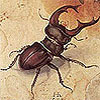|
Gaillard was the son and grandson of Parisian jewelers. In 1892 he took over the directorship of the family firm,
shifting the emphasis to larger-scale metalwork. His designs often incorporated inlaid metals, likely inspired by Japanese examples exhibited at
Siegfried Bing's influential shop L'Art Nouveau. (Gaillard's brother, the noted furniture designer Eugène, was one of the three principal Europeans
whose work was displayed there.)
Around the turn of the century, at the encouragement of his friend René Lalique, Gaillard turned back to jewelry. His designs, like Lalique's,
combined unusual materials, such as horn and ivory, with more conventional precious stones, gold, and enamel. In keeping with typical avant-garde
jewelry design of the time, focus was placed on the overall artistry, thus downplaying spectacular stones. This masterful pendant imitates nature
with consummate accuracy, both in scale and in visual effect: it depicts two opposing moths with intertwined gold antennae. The realistic wings were
carved from a single piece of horn and set with applied brown and iridescent white champlevé enamel to simulate natural markings, while each body was
formed from a cut citrine.
(Entry written by Jared Goss)
Although he is now less well-known than Lalique, Vever and Fouquet, Lucien Gaillard was one of the greatest jewellery designers of his time. This relative oblivion can be explained by the fact that his original production that was briefer and less spectacular than that of his more famous fellow craftsmen.
Gaillard excelled in the use of horn. This choice puts him in the lineage of Lalique who was the first to prefer horn to the traditional tortoiseshell.
This comb illustrates the artist's pronounced taste for humble plant species. In his work there are no human figures, or combinations of motifs taken from flora and fauna. Nor are women's faces and bodies entwined with vegetable arabesques. A single motif is sufficient for each piece of jewellery.
He applied the lessons of Japanese art to his studies. The hawthorn leaves and blossom are seen globally, with only their general characteristics. They are naturalistic but not cluttered with superfluous detail and the sparing design enhances the material.
Here, the horn triumphs in the broad, spreading leaves and thorny stems. The beauty of the material, the quality of the sculpture and the chiselling and the refinement of the patina suffice in themselves. The precious materials, the mother-of-pearl of the petals and the diamonds of the stamens, are used with exemplary restraint.
Yet Gaillard's technique also lends itself to poetic touches. A few flakes of gold, slightly bronzed, suggest the first reddish tinge on the leaves doomed to die.
link
|
